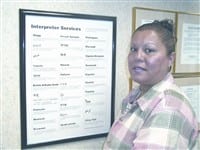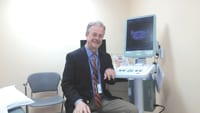The Latest Word A Growing Need For Hospital Interpreters
Ann Marie Martineau remembers well the story of a Polish immigrant who was scheduled to have some blood work done but, when the time came, was reluctant to cooperate with those attempting to provide care.
“When an interpreter asked the gentleman what the problem was,” recalled Martineau, director of Social Services at Baystate Medical Center, “he told them that he couldn’t understand why a group of cleaning ladies was trying to tell him what to do.”
Those cleaning ladies were actually nurses dressed in scrubs, attire that was quite foreign to the recent immigrant. The episode demonstrates how cultural differences can often become a challenge in the administering of health care, and shows the importance of effective communication in that equation.
And as the demographics of the Pioneer Valley continue to change and new groups of immigrants make their mark in Western Mass., communication comes via expanded interpreter services at area hospitals.
Indeed, while all area facilities have provided such services for decades, the need has grown dramatically in the past 10 years, as the Hispanic population continues to swell and new groups, including Russians, Ukranians, Vietnamese, and others, are coming to the Valley in greater numbers.
This phenomenon has given rise to a new type of health care professional — the interpreter — an individual who must facilitate the process of communication between a doctor or nurse and a patient. To handle this assignment effectively, the interpreter must not only know two or more languages, but must also possess much more than a basic understanding of health care and medical terminology.
“That’s because the job entails more than merely interpreting word for word what the doctor says,” said Maureen O’Hare, director of Case Management and Social Services at Mercy Medical Center. “These interpreters must help the individual understand.”
And this can often be an intriguing assignment, said Martineau, who noted that there are many incidents similar to the one involving the Polish immigrant each year.
The Healthcare News looks this month at the growing need for interpreter services in the Pioneer Valley and talks with some of those on the front lines of this evolving health care service.
Talking the Talk
Interpreter services are now guaranteed by law, free of charge, to non-English-speaking individuals. Chapter 66 of the Acts of 2000 — “An act requiring competent interpreter services in the delivery of certain acute health care services” — spells it out in black and white, and in a number of languages.
“Every acute care hospital shall provide competent interpreter services in connection with all emergency room services provided to every non-English speaker who is a patient or who seeks appropriate emergency care of treatment,” the act reads. Visitors to area emergency rooms are greeted by signs that spell out such rights and list the languages — more than 30 of them — that patients can point to in order to delineate their needs.
But long before the services were mandated by law, area hospitals were providing them, said Xenia Rosado Merced, director of Community Outreach at Holyoke Hospital, who said they are a necessity for both patients and providers.
The need is especially acute in Holyoke, she said, where nearly one-third of the hospital’s patients are Hispanic and 15{06cf2b9696b159f874511d23dbc893eb1ac83014175ed30550cfff22781411e5} of the patient population will need some type of interpreting service. “We’re busy people here,” she said, adding that interpreting services are part of a broader umbrella of social services at Holyoke Hospital that include help with transportation and scheduling, translating medical documents into different languages, and assisting patients through the maze that is modern health care.
“In 1995, the hospital recognized the growing needs of the community and established this department in response to those needs,” she said. “Language barriers and transportation needs — these are barriers to quality health care … barriers we’ve tried to remove.”
There is a cost associated with the services, said Merced, acknowledging that it does cost more to care for a patient who needs interpreting services than one who doesn’t, but it is a cost the hospitals must bear — and one the state is now helping with via an initial $1.1 million allocation for all the state’s hospitals — because without effective communication, the task of providing quality care becomes much more difficult.
Asked to quantify the growth of interpreting services at Baystate, Martineau said she could do it in several ways, including the number of patients requesting services and the actual number of “encounters”; the size of her staff; and the number of languages that staff must now handle.
The number of encounters for 2001 was just over 27,000, she said, down from the 1999 figure of 30,860 (although demand was actually higher last year due to different accounting procedures), but more than 10 times the number from a decade ago.
Meanwhile, her staff has grown from a few part-time individuals focusing almost exclusively on Spanish to a department with more than 30 individuals working full time, part time, or on a per-diem basis. Spanish and Russian interpreters are on-call 24/7, and the corps of interpreters now handles about a dozen languages on a regular basis, including Russian, Ukranian, Bosnian, Portuguese, Farsi, and Vietnamese. Interpreters for other languages are obtained on a per-diem basis through local translation services companies or phone services that are becoming increasingly popular.
O’Hare noted similar growth in demand at Mercy, which now has full-time Spanish and Russian interpreters and per-diem employees for several other languages. She attributed the soaring numbers at Mercy and other hospitals to a number of factors, everything from the growing numbers of non-English-speaking people in the area to greater awareness of the services to an ongoing shift from inpatient care to outpatient services Whatever the reasons, the demand for interpreting services is growing, and, as a result, so is the profession.
While not a recognized health care specialty, interpretive service is becoming an attractive and challenging vocation for many, said O’Hare, who told The Healthcare News that when searching for interpreters, Mercy and other hospitals seek out individuals who have some medical background as well as the obvious communications skills. Many interpreters migrate to the field from other positions in health care, she said.
“We look for people who have been certified in some kind of course,” she said, noting that UMass had a course in medical interpreting which was recently cut for budgetary reasons, while many hospitals offer their own classes. “And we also look for people who have a background in medical terminology.”
Speaking Their Language
Those who provide the interpreting services say the job entails much more than the spoken word. Often, there are cultural barriers to cross as well as language barriers, and while it’s not necessarily in an interpreter’s job description to help an individual navigate the area’s complex health care system, this is what often happens.
The primary mission of the interpreter is to facilitate the process of communication, said Hector Rivas, a Spanish interpreter at Baystate for the past five years. “We have to take what the doctor or nurse says and break it down so people can understand it,” he said.
This isn’t done by taking a doctor’s words and putting one’s own spin on them — interpreters are charged with translating word for word with no ad-libbing — but rather by asking the doctor to use different terminology if the patient doesn’t understand, he explained.
Many of the patients he has been asked to help don’t understand words like angioplasty or catheterization in any language, he said, and therefore an interpreter must ask the doctor to continually simplify terminology until the message gets across, he said.
“We have to make sure that the doctor and patient understand each other,” he said. “Sometimes that means asking the doctor to say things in a different way.”
And the message is what’s important, said Luz Filiciano, a Spanish interpreter at Mercy for more than 20 years. She recalled a Mexican patient who was prescribed a medication. When the time came to discuss when the medication should be taken, there was confusion. In the dialect spoken by the man, the word for ‘later’ was similar to the word ‘now’ in Castillian Spanish. The problem may seem like a small one, she said, but when medication isn’t taken as prescribed, it can add up to a big problem.
Ha Pham, a Vietnamese interpreter at Baystate, said he encourages the patients he works with to ask questions so that they fully understand what the doctor or nurse is communicating to them. Most medical terminology, especially in the area of mental health, is foreign to Vietnamese patients, he said, noting that even the word ‘stress’ is new to many of them.
As a result, he often presides over lengthy attempts to draw from physicians and nurses explanations of medical problems — and courses of treatment — that patients can understand.
Beyond the language barriers there are often some cultural issues that must be dealt with as well.
Zina Bliznyuk, who emigrated to the U.S. from Kiev a decade ago and has been a Russian/Ukranian interpreter at Baystate for nine years, said people from former Soviet states are not used to dialogue with their physician. “In Russia, doctors just treat people … they don’t usually tell them anything,” she said. “It’s much different here.”
Also, Russians are generally reluctant to sign consent forms and other paperwork, are wary of medications, and are somewhat distrustful of modern technology, she explained, adding that she often tries to explain the system and how it works to patients. “We often have to help maneuver them through the health care system,” she said.
The Last Word
Today’s complicated health care system can be difficult for anyone to understand and successfully navigate, and it can be especially problematic for those who face language and cultural barriers.
Interpreters are playing an increasingly important role in removing those barriers, helping those from different lands and different cultures communicate with those charged with providing them with medical care — even if they do look like cleaning ladies.




Comments are closed.